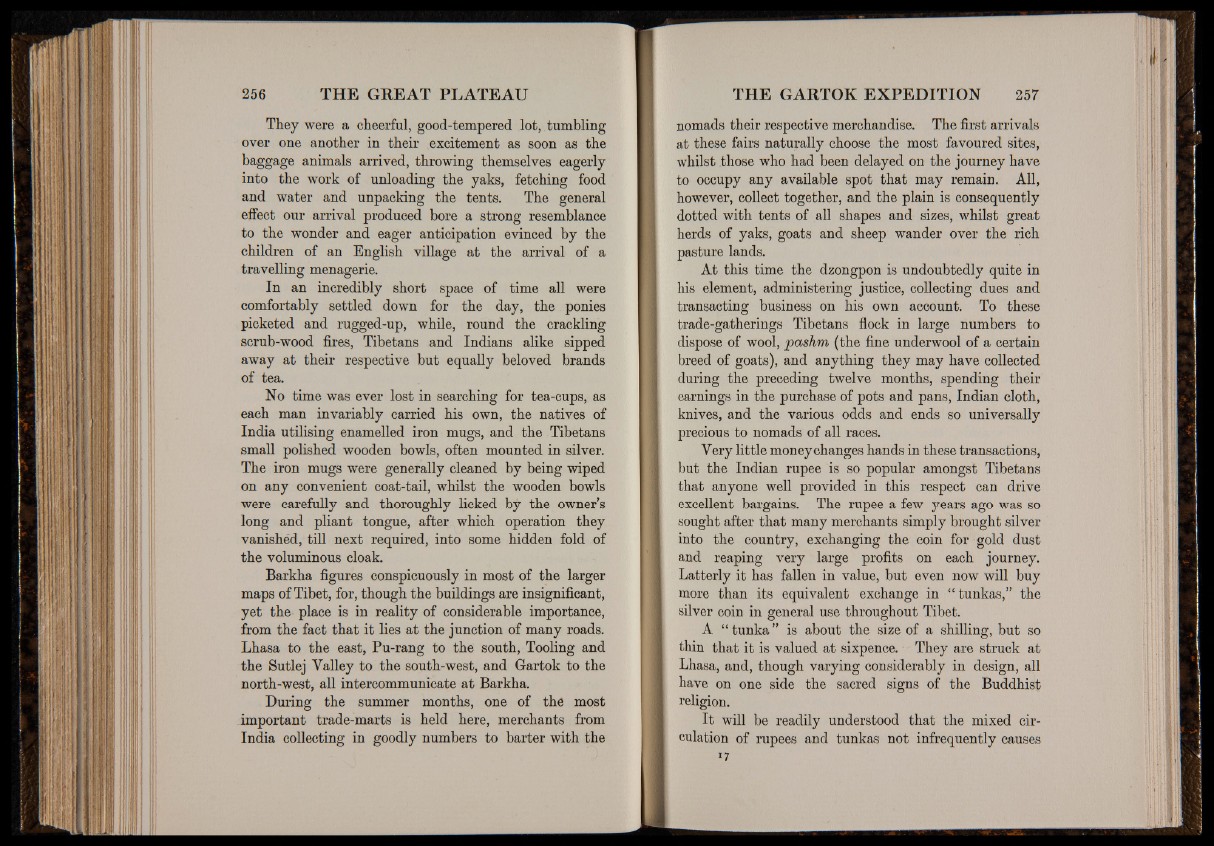
They were a cheerful, good-tempered lot, tumbling
over one another in their excitement as soon as the
baggage animals arrived, throwing themselves eagerly
into the work of unloading the yaks, fetching food
and water and unpacking the tents. The general
effect our arrival produced bore a strong resemblance
to the wonder and eager anticipation evinced by the
children of an English village at the arrival of a
travelling menagerie.
In an incredibly short space of time all were
comfortably settled down for the day, the ponies
picketed and rugged-up, while, round the crackling
scrub-wood fires, Tibetans and Indians alike sipped
away at their respective but equally beloved brands
of tea.
No time was ever lost in searching for tea-cups, as
each man invariably carried his own, the natives of
India utilising enamelled iron mugs, and the Tibetans
small polished wooden bowls, often mounted in silver.
The iron mugs were generally cleaned by being wiped
on any convenient coat-tail, whilst the wooden bowls
were carefully and thoroughly licked by the owner’s
long and pliant tongue, after which operation they
vanished, till next required, into some hidden fold of
the voluminous cloak.
Barkha figures conspicuously in most of the larger
maps of Tibet, for, though the buildings are insignificant,
yet the place is in reality of considerable importance,
from the fact that it lies at the junction of many roads.
Lhasa to the east, Pu-rang to the south, Tooling and
the Sutlej Valley to the south-west, and Gartok to the
north-west, all intercommunicate at Barkha.
During the summer months, one of the most
important trade-marts is held here, merchants from
India collecting in goodly numbers to barter with the
nomads their respective merchandise. The first arrivals
at these fairs naturally choose the most favoured sites,
whilst those who had been delayed on the journey have
to occupy any available spot that may remain. All,
however, collect together, and the plain is consequently
dotted with tents of all shapes and sizes, whilst great
herds of yaks, goats and sheep wander over the rich
pasture lands.
At this time the dzongpon is undoubtedly quite in
his element, administering justice, collecting dues and
transacting business on his own account. To these
trade-gatherings Tibetans flock in large numbers to
dispose of wool, pa shm (the fine underwool of a certain
breed of goats), and anything they may have collected
during the preceding twelve months, spending their
earnings in the purchase of pots and pans, Indian cloth,
knives, and the various odds and ends so universally
precious to nomads of all races.
Very little money changes hands in these transactions,
but the Indian rupee is so popular amongst Tibetans
that anyone well provided in this respect can drive
excellent bargains. The rupee a few years ago was so
sought after that many merchants simply brought silver
into the country, exchanging the coin for gold dust
and reaping very large profits on each journey.
Latterly it has fallen in value, but even now will buy
more than its equivalent exchange in “ tunkas,” the
silver coin in general use throughout Tibet.
A “ tunka” is about the size of a shilling, but so
thin that it is valued at sixpence. They are struck at
Lhasa, and, though varying considerably in design, all
have on one side the sacred signs of the Buddhist
religion.
It will be readily understood that the mixed circulation
of rupees and tunkas not infrequently causes